Anyone who’s spoken to me recently will know that the floor of our Dairy has proved a major problem and a huge source of frustration all round.
Today, finally, we have the beginnings of our resin floor.
Hallelujah!
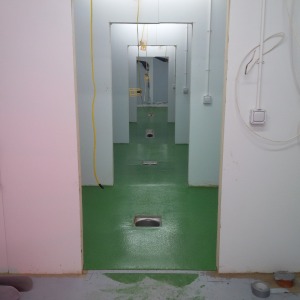
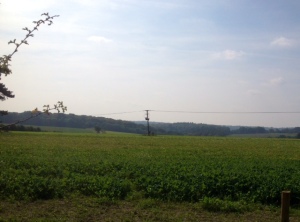
At the beginning of August, I finally moved to Nettlebed. At the time, it seemed that we’d have 6 weeks of build left and at the beginning of October we’d be making cheese. Then it moved to mid October and now it looks a bit longer than that too. Building projects huh?
It’s not that things haven’t been happening though. In fact lots of things have been happening.
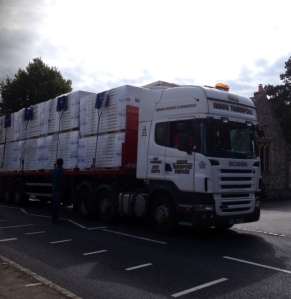
We have internal walls now which is very satisfying to see the building really take shape. From what will be our make room, I can look down the building through what will become the salting and hastening room, warm aging room, cold aging room and ginormous cold room. I can walk through our entrance way and hygiene barrier system and be satisfied that it works. There are scribblings all over the walls showing where the power points are going to be and where our wash down points and hand wash stations are going to be.
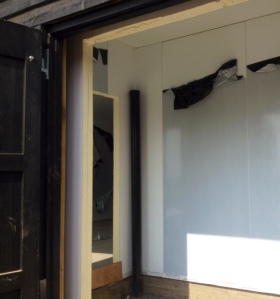
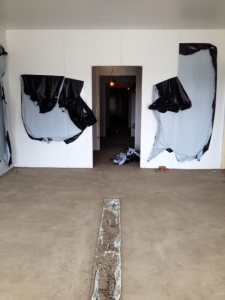
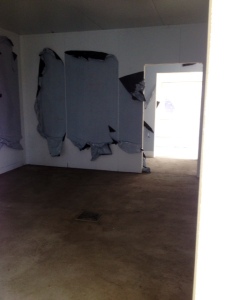
We have drains in place and like the big geek I am, I am so happy with them. We have lovely stainless steel trench drains which are going to be so blissfully easy to clean. There are 2 different types of concrete on the floor: regular concrete and a different mix with a higher sand content that Lee, the man who laid the floor at Trethowans’ Dairy had to specify and order in especially. It was laid down beautifully with the right rises and falls etc and then John Lord who will lay the final resin layer of flooring came to do their work. Unfortunately at this point, things slowed. John Lord were concerned the concrete hadn’t set hard enough and queried if the correct mix had been delivered. Since then many opinions have been given from other flooring firms and concrete suppliers, hammer tests have been done several times and unfortunately our worst fears were confirmed. It wasn’t good enough and needed to be done again.
Meanwhile, Alan Hayes has been shifting the schedule around in order to do as much as possible while we wait for the floor and so the delay can be as minimal as possible. We have electrics going in next week, a phone line and broadband as well. Given that we can’t finish the downstairs until we have a floor, we’ve put more attention on the mezzanine floor, designing an open plan office space but also working out how our changing room plus shower block will work and where our hygiene barrier fits in. We also have a nice big space at the back of the building where we’ll have storage space for filing but also a space for cheese tastings with our customers but also possibly if there’s interest locally, at some point in the future, tastings for the general public.
And I have been practising cheesemaking in the kitchen as my Facebook friends can attest. I’ve also found the enforced wait to be quite useful getting to understand the pace of our starter cultures. We’ve bought cultures from Standa in Normandy on the advice of Ivan Larcher and after much deliberation, we’ve bought 2 different yoghurt cultures and a mesophilic culture which are supplied as freeze dried powder but that we need to bulk as a levain culture before use. One of the yoghurt cultures acidifies a lot quicker than the other, making it quite nice and easy to use but actually the slower culture tastes nicer. Today I have been making cheese in the kitchen again and having made up starter cultures a couple of days ago, I have left the yoghurt cultures straining in cheese cloth. I intend to have them for breakfast tomorrow. I’ll report back. There’s more to be said on the subject of kitchen cheesemaking than one paragraph in a general update post. That’s a topic for next time.
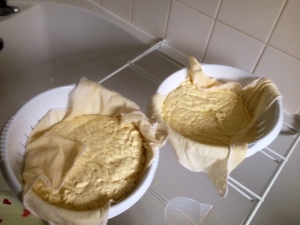
Well, it’s not so long since I was getting excited about concrete being down on the floor and drainage channels being dug. However today, I have received most exciting photos. The outside walls are nearly up. Most of the cladding is up and you can really get a sense of what the building itself will look like finally. It’s looking pretty good, I must say.
Meanwhile, I am still working on HACCP and Quality Systems paperwork. It’s a long haul and will be the subject of another post in due course. Just need to get the stuff finished first!

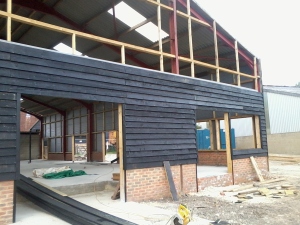


So it has been over a month since I last wrote but buildings are being built, logos are being designed, websites created and as you know from my visit to Avedemil, equipment is being bought.
So, as we left it, we had steels and the best part of a roof. After that, the builders had to dig drainage channels which meant that progress wasn’t hugely visible but was made. Finally however we have concrete on the floors and bits of walls up – brick at the bottom and wooden frames which are going to support traditional dark wood cladding.


As you know I already blogged about visiting Avedemil which was an experience for definite but in a good way. While we wait for our equipment to be delivered, we have also been putting our bursary money to good use by commissioning a website. It’s just a holding page at the moment but with Harry Darby (NYD’s design guru) on our side, we’re hoping for some great things in the future. So far we’ve just decided on our house fonts and incorporated them into the holding site and business cards. Photos are to follow!
In the meantime, I’ve been doing a lot of HACCP. Which, if you’ve done it before, will explain why it’s been a bit quiet on the blog. My head hurts.
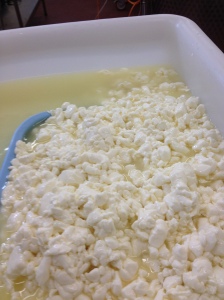
Technical Cheese Geekery – Can’t wait!!
Two years ago the Specialist Cheesemakers Association and Neal’s Yard Dairy held a conference aimed at furthering the links between artisan cheesemakers and the scientific community.
Despite a generously discounted ticket offered by Bronwen Percival, I was too broke to afford to go. At the time, I wasn’t making cheese either so instead of experiencing it in the flesh, I pored over the video files that they uploaded later to listen to presentations, particularly by Marie-Christine Montel on microflora in raw milk.
The dates for this year’s conference have actually been in my diary since last September but there was still a present worry that with all the money we’re spending on building a dairy, going to the conference would stretch the cashflow too far and I’d have to miss it yet again. This year, as we’re hopefully starting to make cheese in July, all the topics which prioritise milk production for raw milk cheese, are even more relevant. Without expecting to get anywhere but thinking we may as well have a go, we applied for a bursary and got one! With the condition that we buy one ticket, we can get another ticket paid by the bursary.
Really looking forward to it. It’s going to be GREAT.
Last week, the Soil Association announced three winners of its Dougal Campbell Cheese Bursary. We applied, for Nettlebed Creamery, in early February and to be honest didn’t really expect to get anywhere. But we did. In fact we are one of the winners!
Dougal Campbell was a very influential figure in the Specialist Cheese industry who I’m afraid I never met. I do know people who speak feelingly of how inspirational and generous he was with his knowledge and time. If it weren’t for him, we wouldn’t have either Lincolnshire Poacher or Hafod on our cheeseboards to name but two.
I do remember his cheese though. In the mid 90s when I was fresh out of university and learning the ropes at this quirky shop in Covent Garden called Neal’s Yard Dairy, we received a delivery of some of the last Tyn Grug cheeses he had made before he died. Possibly because it coincided with me learning to set up a display and learning to sell and taste out cheese to customers, I can still l distinctly remember the big, heavy natural-rinded wheels that could be built into a pleasingly eye-catching tower. I remember the cheese’s golden colour and a fruity flavour that flirted with wildness. I also remember the sadness at his death that was felt at Neal’s Yard amongst the more experienced mongers behind the counter who had met him and knew the cheese and its maker considerably better than I did. It feels very apt to have the influence of this cheesemaker again as I’m embarking on another new learning curve.
In order to apply for the bursary, we had give details of how our farm is managed along organic guidelines and our intentions for the cheese. I found it pretty interesting, not least learning about what Phil the farm manager does. With a bit of luck you will too.
Nettlebed Creamery is a new business and we are in the process of building a dairy with the aim of making a washed rind cheese and a blue cheese using the organic milk produced on the Nettlebed Estate at Merrimoles Farm.
Merrimoles Farm has been in the Fleming family since 1901. The farm is a mixture of arable, sheep and dairy. The Dairy has been sited at Bix since 1969; it became organic in 2004.
There are over 130 cattle in the dairy herd. They are cross-bred Holstein Fresians with Swedish Reds and Montbelliards.
Some specific farming practices with a view to sustainability
The herd are fed using as much home grown feed as possible including in addition to grazing: clover silage, whole crop barley, grain and beans (approx. 15% is purchased – parlour cake). The growth of pasture and feeds are managed using a rotation including clover crops to fix nitrogen and provide fodder.
The cross breeding of the dairy cows (Holstein-Friesian, Swedish Red & Montbeliards) has been undertaken to maintain hybrid vigour and provide long lasting, healthy, fertile animals.
The farm is in the Organic Entry Level Scheme (OELS) and has established grass margins, maintains hedgerows and trees and has areas of low input grassland to maintain and increase biodiversity. They alternate grazing with sheep where possible to limit the effect of internal parasites, reduce the need to worm and therefore avoid wormer resistance worms. They use 500t of Green Waste Compost annually to maintain soil reserves and avoid using finite mined fertilisers. In addition they have invested in energy saving electric motors and a heat recovery unit at the dairy (milking) to reduce our energy use.
The Creamery, we are building, is designed taking energy efficiency into account. We will be using water from our neighbour’s woodchip boiler for all our hot water and for our heating as well. We have plans to use solar panels from the roof of the barn next door (our landlord is finalising these plans currently). After our first year of cheese making we will be creating a wetland system to take all the grey water, sewage and the whey from the facility: a system of swales and ditches to filter the waste into clean water. We then intend to plant fruit trees and willows, rushes and wild orchids to assist with the water filtration and at the same time encourage biodiversity.
The cheeses we intend to make will be made using raw milk and using traditional, liquid yoghurt starter cultures. Eventually we intend to culture our own starters and ripening agents solely from the raw milk produced by the estate and vegetable matter grown on the estate (a valuable potential source of lactic acid bacteria), eliminating the need for bought in cultures.
The cheeses will be entirely made by hand which suits the production of soft and blue cheeses best. We will use open vats and the cheese will be made without the use of mechanical stirrers as our soft and blue cheeses require a more gentle handling. A comprehensive set of maturing rooms has been designed to then ensure the cheeses are kept at the appropriate humidity and temperature at all stages of their ripening.
By building a dairy we intend to provide the farm with a future for its Dairy herd which is no longer subject to the fluctuating prices of the milk market. The need for an alternative customer to the current purchaser on the farm was highlighted at a point when the milk price and amount of organic premium was cut without very much warning.
Our dairy will negotiate a fair milk price for the farm that allows them to be profitable and importantly that is guaranteed. In return for milk being produced to specific standards regarding bacterial levels and fat and protein content our milk price can be increased. In addition to cheese, we have plans to investigate the possibilty of using more of the farm’s milk to produce a range of yoghurts and frozen yoghurt. This in turn will allow the farm to maintain and improve on its current sustainable practices and will mean it does not have to dramatically increase herd size in order to turnover more money.
Re-reading this, although these are the aims we’ve talked about since the beginning it does make me feel a little nervous as our aim of fair milk price and providing a sustainable future for the herd will only work if the cheese is as good as I can make it and therefore we sell plenty of it.
No pressure!!
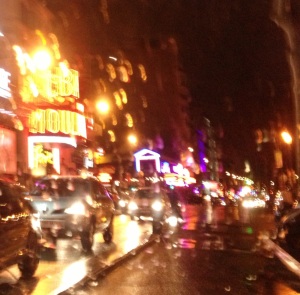
As Audrey Hepburn apparently said, ‘Paris is always a good idea’. Even better if it happens to be hosting an agricultural show which according to Patricia Michelson of La Fromagerie and various other cheesemakers, is a must see.
With hopes of learning more about farming and cheesemaking equipment, Rose and I booked the Eurostar and set off. It took a relatively short metro ride to get to Paris Expo and we were able to buy our entry tickets to the Salon d’Agriculture pretty easily. We acquired lunch and looked at some cows, picking up leaflets on Montbeliards as we went and perused the map trying to find the Salon de Fromage.
Apparently it’s all been a bit easier to find and get into in other years but this year it took full on detective work to find the cheese bit of the show. This is partly because it’s for professionals only and perhaps the guards last year just got fed up of turning away members of the public but all the same it was due to a good degree of exploration of the site and some fine ad lib blagging on Rose’s part and translation on my part that we got in.
We had business cards for Rose’s old business and luckily because we’d planned on talking about it on the train we had a plan showing the design of our dairy. We first profered the business cards. No good. We called people we knew who were in there. They weren’t answering their phones. Rose got out the plans of the dairy and began talking the security guard through the process in franglais. At this juncture, he realised we were
a) obstinate
b) legitimate
c) possibly slightly deranged
and sent us chasing after a nice lady in a green jacket who officially lead us past the security and to the desk in the hall where you presented your business cards and were allowed to register as a visitor. Not entirely sure why it had been so cloak and dagger to get to that point but never mind, we were in.
Inside, we wandered around lots of stands of cheese in its many and varied forms. We stopped by An Bord Bia’s stand and looked at their cheeses, unfortunately just missing a chance to say hi to the Furnos from Cashel Blue. We found Guffanti’s stand and tried their Taleggio and different types of Gorgonzola. They were really good. We, of course, said hello at the Neal’s Yard Dairy stand and in the course of conversation that networker par exellence that is Jason HInds managed to direct us to a good paper supplier and to a nice cheese affineur called Mark who loved the idea of people going into making cheese and has offered to take us to visit some Reblochon producers in May or June. We also ran into Jonny Crickmore who had come over on a very early train with Julie Cheney and who were both just leaving but we just had time to chat and compare notes on milk testing and things to look at in the cheese show.
After that as we partook of a nice glass of wine (well when in Paris…) at the show’s wine bar / restaurant we took stock, talked about website, packaging, labelling and other things that had absolutely nothing to do with vats and stainless steel but were very productive nonetheless. And as we rounded the corner on a final tour of the show we managed to finally track down my sister and the inimitable Jon Thrupp who were chatting away to their Beaufort affineur. They were mid meeting so there was only really a chance to say a quick hello but it’s always nice to run into friends and family even if it is only brief.
Having successfully found paper, Reblochon hosts and had a chance to chat cheese with Julie and Jonny, we set off for the Gare du Nord so Rose could catch a train home. I stayed on in Paris for a very quiet night in (it had been a very early start) hence the photo of the Moulin Rouge from my taxi and returned to Blighty the following morning slightly regretting not having more time to do a good visit to the recommended Fromageries and buy up all the washed rind cheese I could.
Paris is great. I could have stayed all week!


‘There seems to be rather less of it than there was before,’ my mum said as I proudly showed her the photos that proved work was continuing on our building site, ‘Is that right?’
It is right although it’s understandable that it doesn’t immediately seem like a step forward. Before the new roof goes on and the external wood cladding, they have to remove the old roof that needs to be replaced and check the metal structure for repairs. Next step will be repairs to the frame and to the concrete foundations that each steel stanchion sits in. After that, comes the excitement of new roof and the walls going up.
Until then, in this instance, less is actually more.


It takes the working world a while to get going again after its Christmas break. Having felt like we were making progress on the build just before Christmas, January proved to be a very slow month of chasing up people who had said they would do something to see if they had done what they said they would.
Our first delay was waiting for straw to be moved from inside our barn which we thought needed to happen before any assessment of the existing structure could take place. As it was slow going, Rose tried to organise a site meeting and a digger to look at the foundations of the steel framework holding up the roof around the straw and did manage to find out a few basics. The aim, having agreed on an interior layout was to check how stable the existing barn structure was and what would need repairing. A cherry picker ensured that she was able to assess the existing roof and that it would need repairing extensively – in other words a new roof. The digger revealed that the concrete bases to our steel stanchions were a bit hit and miss. Some of them were in place and working fine but others had eroded away and as a result water had accumulated at the base of the steel, weakening the structure. More repairs would be necessary.
Rose also held talks with our neighbours with whom we share a party wall and who are also installing a wood chip boiler that we are going to be able to use for our hot water and heating requirements. Negotiations over the wall and any ramifications from our building were carried out amicably and they were able to show Rose a picture of how Manor Farm had looked in the early 1900s when it had been a working dairy farm (above – the photo shows what is now their house and garden and our dairy will run to the south of that). Building a cheesemaking dairy on the site of a dairy farm feels very appropriate somehow.
When the straw was finally removed and the site boundaries marked with metal gates, further information could be gleaned. The concrete floor was revealed showing sections with a herringbone pattern which we believe is the floor of the milking parlour of the original dairy at Manor Farm. Drains have been discovered. Although the existing drain onion that they would have fed into isn’t usable any more, it is still handy to know there are channels there for us to start from. A long deceased and dessicated stoat has also been discovered – not a feature we intend to preserve.


A local structural engineer undertook to take on our structural drawings so that the builder who will be carrying out our external cladding and roof repairs could get going. He seemed to move rather slowly getting a quote out for the work. Unfortunately after a further fortnight of chasing and reminding, he admitted to being swamped with other work and had to give up. Alan Tucket to the rescue (the builder) as he has a structural team who have taken that over. As a result, work should start very soon.
In short, a funny period of meetings and activity for Rose and not so much for me. A lot of chasing, hassling, reminding and getting bits and pieces ready so that the build can start. Progress is being made. We are getting closer to the day that building begins but as yet the earth hasn’t moved (quite literally). It’s a bit like that stage before you go on holiday where you’re doing the packing and trying to remember everything you might need; a little nerve wracking and tense as you hope you’ve planned everything as well as possible and still too early to have set off and be able to say to yourself
‘Sod it, if I haven’t thought of it by now, I’ll just have to deal with it when it happens.’
